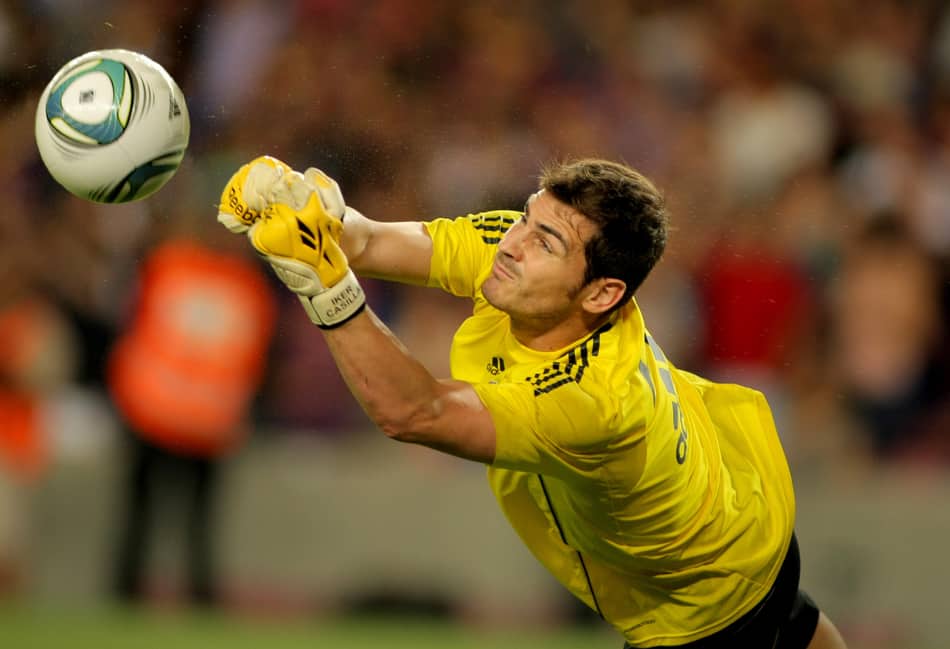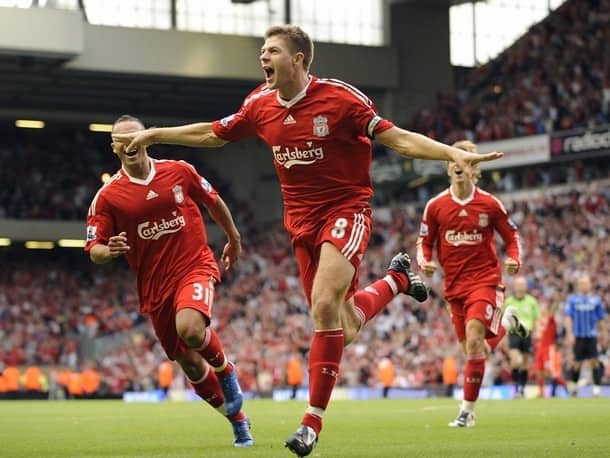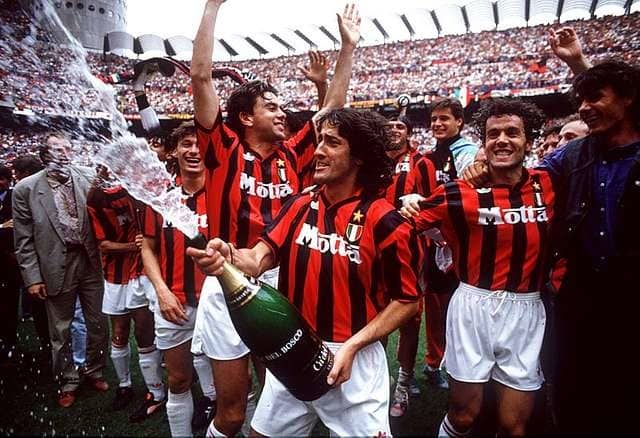
After over 30 years of being involved in football from amature to professional, either as a player or a coach, I have had experience with numerous formations such as the 4-4-2.
The strength of the 4-4-2 is that it covers the majority of space along the horizontal lines on a football pitch, with the exception of the opposition’s full-back areas that pose no imminent threat. The weakness is the team being stretched, exposed to overloads in central areas and vulnerable between the 3 lines.
For many years, especially in the English league, 4-4-2 was the default setting for many teams. In the rest of this blog post we will take a more detailed look at…
- Why 4-4-2 was so popular in the England
- Individual roles
- Successful 4-4-2 teams
- Is 4-4-2 outdated?
- Modern day adjustments
- How do you play 4-4-2 effectively?
- Is the 4-4-2 Making a comeback?
Why 4-4-2 was so popular in England
In my personal opinion the biggest reasons for the popularity of the 4-4-2, over previous years, is due to two main factors:
- Cultural
- Simplicity
Cultural
When a player has been playing in a 4-4-2 system throughout their youth and professional career, it then becomes intrinsic in how they think and what they do.
Upon becoming a manager/head coach, the majority of ideas that the individual has, such as team formation and training methods, will have been unconsciously formed during the learning years as a player and continued during the player’s senior years.
It is difficult to turn your back on something that you have been doing for the majority of your life and so a new manager will most probably copy their experiences by playing a 4-4-2, with similar training methods, and this cycle is repeated over generations.
This is probably one of the major reasons why the 4-4-2 became ingrained within the English football culture.
For this reason it was the influence of the first foreign coaches, who started to come and work in the Premier League, that helped to broaden the English games coaching culture and open up the minds of younger coaches, players to new formations and ways of playing.
Simplicity
The individual and collective roles in the 4-4-2 formation are very simple to understand. It can help young players to learn the basic principles of a specific position on the pitch.
These principles acquired will then form a foundation for when players start to learn new formations.
The 4-4-2 does not allow for any passengers (players who are not fulfilling their responsibilities).
Whilst each coach might have slight variations within this formation, the roles that follow are a general overview.
Roles
Goalkeepers

The emphasis on goalkeepers predominantly playing out from the back and playing like an outfield player in possession is not as demanding in this formation.
Whilst teams may at times play out from the back, in the 4-4-2 teams do have the option to play longer balls.
These longer balls will generally be aimed at either the two strikers or out wide to the winger, where one of the strikers will get close to the winger to try and create a numerical advantage.
This means that there is not as much demand for the keeper to possess such high technical ability with their feet.
The keeper’s job is to be good at keeping the ball out of the net and the basic specific requirements of a goalkeeper.
Full-backs
First and foremost a full-backs job is to defend.
If the play is on the opposite side of the pitch then the full-back must shift across to provide cover for the Central defender.
When the team is in possession of the ball, it is expected that the full-back will offer support to the wide player and when needed, make overlapping runs.
Central defenders
Again, primary job is to defend but since a central defender can see the entire pitch, the player must communicate well with others regarding
- Positioning of the defensive line (push-up or drop)
- Checking full-backs positions (when shifting left to right)
The role requires the player to cover the full-back, if they are beaten by the opposition’s wide player and be dominant in the air.
Centre midfielders

These two players are expected to
- Defend
- Attack
- Provide cover (when players are caught of position)
A lot is expected of players in this position therefore they must possess a number of attributes that create a more all rounded player.
Right / left midfielder (wingers)
Due to the evolution in formations, the term winger is not used as much as it was when the 4-4-2 was the main formation.
Also, the reason I also named this section right and left midfielders is due to the type of player that might occupy this position.
If you would like to know the difference between the two then this will be explained later in this blog.
Commonly this player would have the responsibility of supplying crosses into the penalty area.
This player would stereotypically be:
- A good dribbler
- Good in 1v1 situations
- Good crosser of the ball
- Generally quick (but not always)
Centre forwards (strikers)
Having two strikers means that the opposition’s central defenders may have less time on the ball.
The main advantage to having two stickers is that they can both support each other and work in tandem. This avoids the problem that other formations might find where a sole striker is isolated
Partnerships
Many of the most successful teams, that used the 4-4-2, had two Centre forwards who worked well as a partnership.
Some of the best Centre forward partnerships have been:
- Andrew Cole & Dwight Yorke (Man Utd)
- Robbie Keane & Dimitar Berbatov (Spurs)
- Alan Shearer & Chris Sutton
- Kevin Keegan & John Toshack (Liverpool)
At times, it would seem as though these partnerships had a telepathic relationship as they would just know what the other one would do before they actually did it.
Check out this video as an example.
Overall, the 4-4-2 formation relied upon the team being compact, everyone shifting simultaneously together as a unit and having good partnerships all over the pitch.
It also offered a good variety of attacking options from the wide positions and down the middle.
Success
For English clubs, this formation proved to be very successful for a long time, including dominating in Europe during the 70’s and early 80’s.
The formation was also adopted by other European teams. In fact, arguably AC Milan’s greatest team that included the likes of: Van Basten, Gullit, Ancelotti, Rijkaard, Baresi and Maldini played with the 4-4-2 formation.

Is the 4-4-2 Outdated?
The consensus is that the 4-4-2 is outdated and too rigid. Whilst it may have its limitations, over the years teams have slightly adjusted the formation to combat the 4-3-3 and more specifically to stop the opposition’s deep defensive midfielder from having too much time on the ball.
4-4-2 Modern Day Adjustment
When out of possession teams will drop one of their strikers into the hole, between the forward and the midfield line, making the formation into a 4-4-1-1 to provide a bit of help in the middle when playing against a three man midfield.
This led teams to look for a certain type of player to full-fill this role that may not necessarily be a typical out and out centre-forward.
A good example of this can be seen during Sir Alex Ferguson’s era at Manchester United. Ferguson played a 4-4-2 for many years and then reverted to a more 4-4-1-1 and used a specialist link player just behind the main striker, such as:
- Teddy Sheringham
- Dwight Yorke
- Dimitar Berbatov
How Do You Play 4-4-2 Effectively?
In order to be effective in this formation it should be noted that the following will be needed by the player:
- Desire to work hard
- Mental strength
- High level of fitness
- Quality and composure on the ball
Desire To Work Hard
4-4-2 leaves no hiding players for individuals who are not prepared to work hard for the team, both in and out of possession.
Central and wide midfielders must be prepared to get forward in attacking phases but also quickly return into positions behind the ball when possession is lost.
If one player fails to achieve this then the whole team will be stretched, with gaping holes in certain areas of the field which cannot be filled by other members of the team.
Mental Strength
Players must accept that, if a team has a numerical advantage in the middle of the park then possession percentage might be low.
This should not discourage the team as this will not necessarily determine the outcome of the match.
So with a low percentage of possession, players must not get discouraged but instead stay true to the team’s objective.
High Level of Fitness
It goes without saying that all players should be in good physical condition to perform but it is imperative that the central midfielders and wingers are super fit.
The distances that these players will cover may be between 10km – 13km.
Quality and Composure on the Ball
With the team likely to concede the majority of possession, it is extremely important that once the ball has been won, the team uses the ball well. This could be keeping possession if no immediate attack is available or playing that killer pass on the counter-attack to score.
Is the 4-4-2 making a comeback?
The 4-4-2 has not completely vanished and nor do I think it ever will but long gone are the days when the majority of teams, at the highest level, will be adopting this formation.
In regards to the English Premier League, the most successful team in the last few years was the Leicester City team that won the title in 2015/16.

Even though there were some subtle tactical differences, such as Mahrez moving inside and Okazaki sometimes dropping in behind Janie Vardy, in the main it was a 4-4-2 formation.
Another Premier League team that has played with a 4-4-2 formation for several years has been Burnley. Burnley have enjoyed relative success for several years using this formation.
It has seen them return to the Premier League, after being relegated in 2014/15, at the first attempt, finishing 7th in 2017/18 (qualifying for the Europa League) and maintaining their Premier League status despite spending very little in the transfer market.
A variation of the 4-4-2 has been the diamond formation. In the rest of this article, we will look at the strengths and weaknesses of the 4-4-2 diamond along with, what is the best formation against the 4-4-2?
4-4-2 Diamond Formation
The diamond formation is a variation of the line-up that is designed to take back control of the midfield area.
Set-up
The back four remains the same along with the traditional two strikers but the midfield four form a diamond shape.

Strengths of the 4-4-2 Diamond
- Extra protection in front of the centre-backs (with the defensive midfielder
- Generally there is a numerical advantage in the middle of the pitch (4v3)
- Opportunity to play two strikers
Weaknesses of the 4-4-2 Diamond
- A lack of width
- Two of the central midfielders may have to keep shifting across more than normal
- Depending on the full-backs to get into high attacking areas out wide
Although the biggest downside to this formation is the lack of width in advanced areas, this problem can be reduced if the team contains players who are flexible in their roles.
An example of this might be the defensive midfielder dropping between the two centre-backs and therefore pushing both full-backs further up the field whilst still retaining at least three players in the centre of the field.
This variation also famously became known as the christmas tree when Terry Venables used it for his England team during the 1996 European Championships.
To give you an example of how this looked, the England team lined-up like this…
How To Beat The 4-4-2 Diamond Formation
The tactics needed to overcome this compact formation is to first exploit the wide areas by creating 2v1 situations with the wide player and full-back against the opposition’s full-back.
This will probably make the opposition drag one of their players out to the wide areas which means space has opened up in the centre.
What is the best formation against the 4-4-2?
Each and every coach will have their own idea of what formation will conquer the 4-4-2 and I know that there are more than one.
So it is good to remember that this is just an opinion & I will not be able to cover every formation that might be better than the 4-4-2 in this blog.
I am going to look at two formations to beat the 4-4-2 which are:
- 4-3-3
- 3-5-2
4-3-3
If the 2 strikers (in the 4-4-2) place pressure on both central defenders, stopping them from starting play from the back and the wingers do the same with the full-backs, this will allow space for the deep lying defensive midfield player to pick up the ball and set up the attacking phase.
This causes the opposition’s midfield a huge problem, simply due to being outnumbered in the midfield area.
This also allows at least one of the midfielders, if the opposition try to close the defensive midfielder down, to be able to find space in between the rivals midfield and defensive line.
3-5-2
As with the 3-5-2 formation, this provides a numerical advantage in the back line to start the build-up play.
Also, like the 4-3-3, it creates an overload in the middle of the pitch that helps the team to have a greater percentage of possession.
The formation maintains the ability to have 2 players up front who can support each other, whilst also gaining attacking options out wide through the wing-backs.
A great benefit to the 3-5-2 is that it has numerous attacking options and allows the team to have plenty of players attacking the penalty area, when crosses are placed into the penalty area, with the knowledge that there is still plenty of defensive cover if the ball is lost.
Earlier in the blog post I mentioned that I would explain the difference between a right/left midfielder and a winger. So, for the final part of this blog that is what I will do.
Difference between a right/left midfielder and a winger

To be clear, the difference between the two is not a positional matter but more of an individual player characteristic.
A winger is a player that can go past players, either with speed, a trick or both and likes to get plenty of crosses into the box.
As a kid, playing in this position, I was always taught that great wing play was going past the full-back, getting to the by-line and cutting it back for the striker.
Here is a list of players that I would personally consider as wingers:
- John Barnes
- Ryan Giggs
- Andrei Kanchelskis
- Chris Waddle
- Jadon Sancho
In contrast, a right/left sided midfielder is a player that is more a central midfield player but can operate out wide. These players might not necessarily be as attack minded as a winger but may actually offer a more defensive balance to the team.
A great example would be David Beckham. Even though Beckham spent the majority of his career on the right hand side, contributing many incredible crosses, his style was not to jink past players and get to the by-line.
